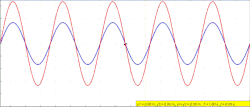Standing wave
|
|
|
|
In physics, a standing wave – also called a stationary wave – is a wave that oscillates in one constant position.
The word oscillate simply describes the vibrating movement of particles in a medium when acted upon by a wave, or the regular up and down motion shown in the animation. Oppositely to a progressive (moving) wave, stationary waves do not transfer energy in a given direction when they oscillate.
When a guitar string is plucked, for example, a stationary wave is formed. This happens because on releasing the string, two progressive waves move down the string in opposite directions. When they reach the point where the string is tied down, they cannot move beyond this boundary. At the boundary, the wave is reflected and travels back in the opposite direction. The two reflected waves meet and interfere with one another. Superposition occurs, the opposing directions of the reflected waves cancel out resulting in one stationary wave.
Standing Wave Media
Standing waves in a string – the fundamental mode and the first 5 harmonics.
Transient analysis of a damped traveling wave reflecting at a boundary
The hexagonal cloud feature at the north pole of Saturn was initially thought to be standing Rossby waves. However, this explanation has recently been disputed.
Standing waves in a string – the fundamental mode and the first 5 harmonics.







